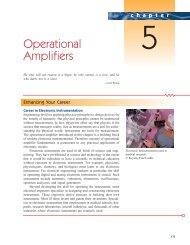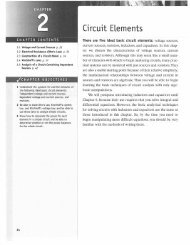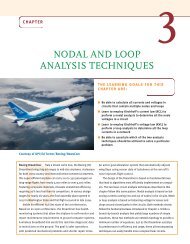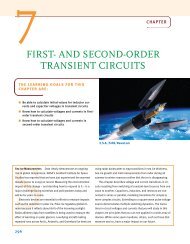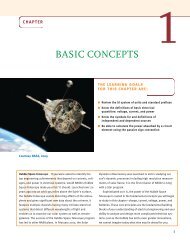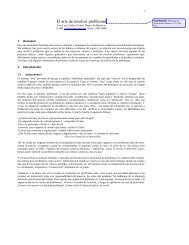Fundamentals of Electric Circuits
Fundamentals of Electric Circuits
Fundamentals of Electric Circuits
You also want an ePaper? Increase the reach of your titles
YUMPU automatically turns print PDFs into web optimized ePapers that Google loves.
3.8 Circuit Analysis with PSpice 105<br />
The first factor is the nature <strong>of</strong> the particular network. Networks<br />
that contain many series-connected elements, voltage sources, or supermeshes<br />
are more suitable for mesh analysis, whereas networks with<br />
parallel-connected elements, current sources, or supernodes are more<br />
suitable for nodal analysis. Also, a circuit with fewer nodes than<br />
meshes is better analyzed using nodal analysis, while a circuit with<br />
fewer meshes than nodes is better analyzed using mesh analysis. The<br />
key is to select the method that results in the smaller number <strong>of</strong><br />
equations.<br />
The second factor is the information required. If node voltages are<br />
required, it may be expedient to apply nodal analysis. If branch or mesh<br />
currents are required, it may be better to use mesh analysis.<br />
It is helpful to be familiar with both methods <strong>of</strong> analysis, for at<br />
least two reasons. First, one method can be used to check the results<br />
from the other method, if possible. Second, since each method has its<br />
limitations, only one method may be suitable for a particular problem.<br />
For example, mesh analysis is the only method to use in analyzing transistor<br />
circuits, as we shall see in Section 3.9. But mesh analysis cannot<br />
easily be used to solve an op amp circuit, as we shall see in Chapter 5,<br />
because there is no direct way to obtain the voltage across the op amp<br />
itself. For nonplanar networks, nodal analysis is the only option,<br />
because mesh analysis only applies to planar networks. Also, nodal<br />
analysis is more amenable to solution by computer, as it is easy to program.<br />
This allows one to analyze complicated circuits that defy hand<br />
calculation. A computer s<strong>of</strong>tware package based on nodal analysis is<br />
introduced next.<br />
3.8<br />
Circuit Analysis with PSpice<br />
PSpice is a computer s<strong>of</strong>tware circuit analysis program that we will<br />
gradually learn to use throughout the course <strong>of</strong> this text. This section<br />
illustrates how to use PSpice for Windows to analyze the dc circuits we<br />
have studied so far.<br />
The reader is expected to review Sections D.1 through D.3 <strong>of</strong><br />
Appendix D before proceeding in this section. It should be noted that<br />
PSpice is only helpful in determining branch voltages and currents<br />
when the numerical values <strong>of</strong> all the circuit components are known.<br />
Appendix D provides a tutorial on<br />
using PSpice for Windows.<br />
Use PSpice to find the node voltages in the circuit <strong>of</strong> Fig. 3.31.<br />
Solution:<br />
The first step is to draw the given circuit using Schematics. If one<br />
follows the instructions given in Appendix sections D.2 and D.3, the<br />
schematic in Fig. 3.32 is produced. Since this is a dc analysis, we use<br />
voltage source VDC and current source IDC. The pseudocomponent<br />
VIEWPOINTS are added to display the required node voltages. Once<br />
the circuit is drawn and saved as exam310.sch, we run PSpice by<br />
selecting Analysis/Simulate. The circuit is simulated and the results<br />
120 V<br />
Example 3.10<br />
1 20 Ω 2 10 Ω 3<br />
+ − 30 Ω 40 Ω 3 A<br />
0<br />
Figure 3.31<br />
For Example 3.10.




